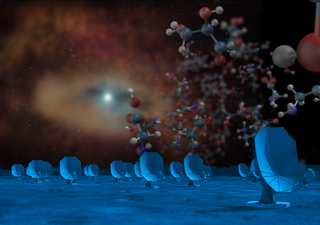ngVLA Special Session: Chemical Probes of Astrophysical Systems
 |
American Astronomical Society winter meeting
|
 Astrochemistry has become a critical investigative tool for a large range of astrophysical studies, spanning Solar System objects to the most distant galaxies. The investigation of extrasolar planetary systems is one of the defining pursuits of contemporary astronomy, using complex chemical tracers to identify the conditions that ultimately lead to habitability. Extraterrestrial amino acids, the chemical building blocks of the biopolymers that comprise life on Earth, are present in meteoritic samples and in comets, but our understanding of the chemical and physical pathways to the formation of (pre)biotic molecules remains incomplete. On galaxy scales, the presence of various molecules and associated isotopes indicate the role of energetic processes (e.g., shock, UV, and cosmic-ray heating) affecting interstellar medium conditions and pathways to the formation of the next generation of stars. While existing facilities are making transformative discoveries by pushing their capabilities to the limit of what can be detected, sample sizes remain small as detections of individual systems are limited to the nearest luminous sources. Informed by these pioneering efforts, next-generation ground- and space-based facilities will deliver large, multi-wavelength surveys that will produce spectroscopic information across the entire electromagnetic spectrum. These data will deliver a much-improved theoretical understanding of the fundamental physics driving the formation of habitable planetary systems as well as the formation and evolution of galaxies over cosmic time.
Astrochemistry has become a critical investigative tool for a large range of astrophysical studies, spanning Solar System objects to the most distant galaxies. The investigation of extrasolar planetary systems is one of the defining pursuits of contemporary astronomy, using complex chemical tracers to identify the conditions that ultimately lead to habitability. Extraterrestrial amino acids, the chemical building blocks of the biopolymers that comprise life on Earth, are present in meteoritic samples and in comets, but our understanding of the chemical and physical pathways to the formation of (pre)biotic molecules remains incomplete. On galaxy scales, the presence of various molecules and associated isotopes indicate the role of energetic processes (e.g., shock, UV, and cosmic-ray heating) affecting interstellar medium conditions and pathways to the formation of the next generation of stars. While existing facilities are making transformative discoveries by pushing their capabilities to the limit of what can be detected, sample sizes remain small as detections of individual systems are limited to the nearest luminous sources. Informed by these pioneering efforts, next-generation ground- and space-based facilities will deliver large, multi-wavelength surveys that will produce spectroscopic information across the entire electromagnetic spectrum. These data will deliver a much-improved theoretical understanding of the fundamental physics driving the formation of habitable planetary systems as well as the formation and evolution of galaxies over cosmic time.
This Special Session will:
- Highlight recent scientific breakthroughs in astrochemistry enabled by current investigations using large optical/IR, (sub-) millimeter, and radio facilities;
- Describe planned near- and long-term improvements for ground- and space-based facilities;
- Discuss major scientific leaps likely to result from next-generation facilities across the electromagnetic spectrum; and
- Review the highest-priority themes in the field of astrochemistry that will be accomplished by the state-of-the-art observatories that will be commissioned in the next decade.
Confirmed Invited Speakers
| Title | Speaker | Affiliation |
|---|---|---|
| Prebiotic Molecules | Brett McGuire | Massachusetts Institute of Technology |
| Organics in the Mid-Planes of Protoplanetary Disks | Kamber Schwarz | University of Arizona |
| Exoplanet Atmospheres | Eliza Kempton | University of Maryland |
| The Chemical Path from Envelope to Planet | Dominique Segura-Cox | University of Texas – Austin |
| The Complex Chemistry of Comets | Stefanie Milam | NASA GSFC |
| Deciphering Galaxy Energetics Through Chemistry | David Meier | New Mexico Tech |




Connect with NRAO